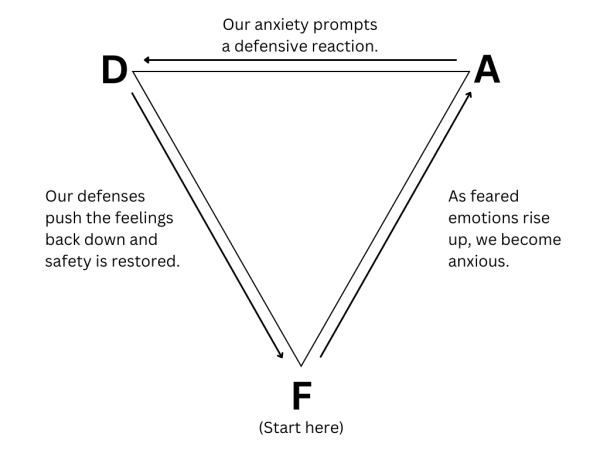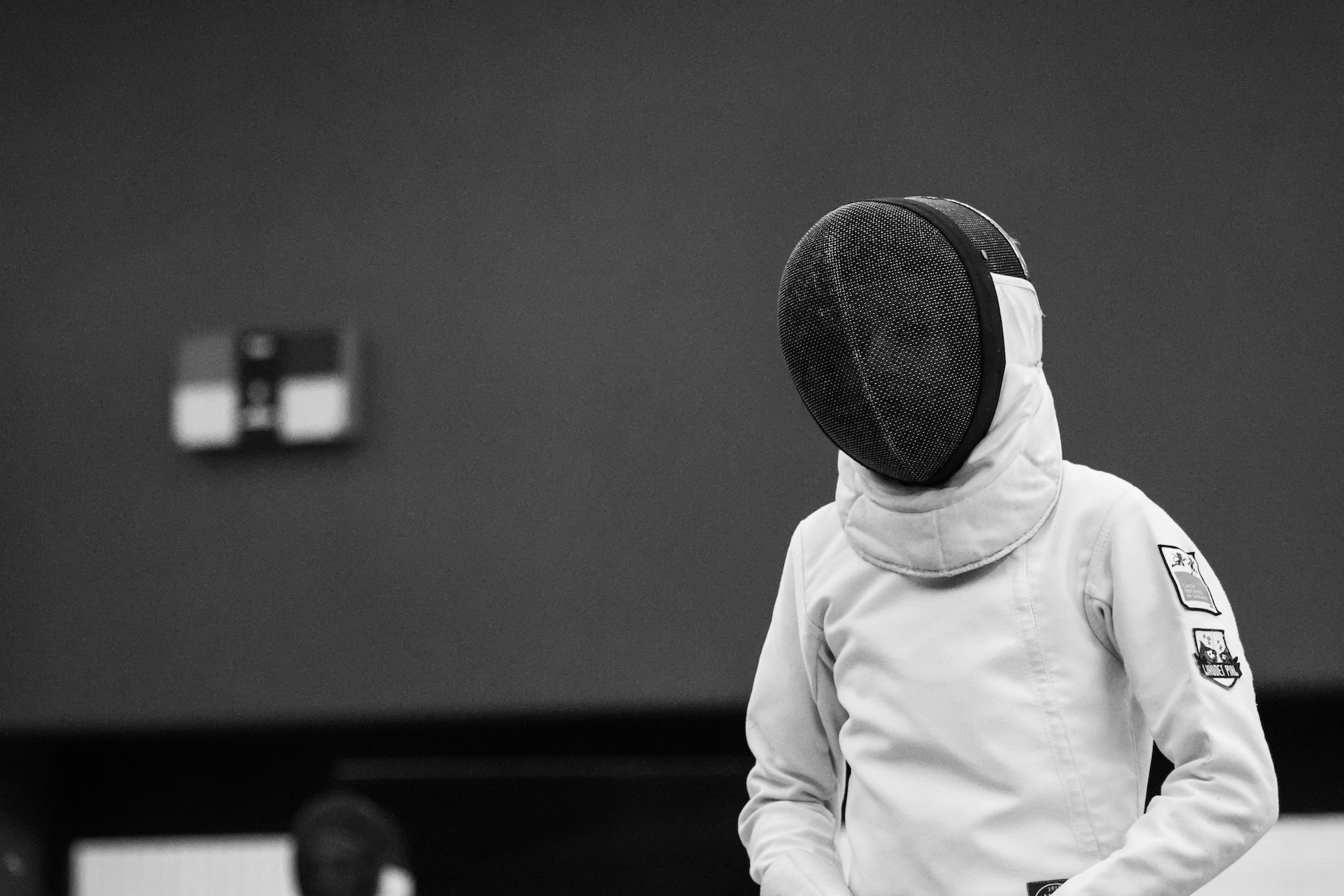This is the third instalment of a 3-part series in which we look at the Triangle of Experience tool and how it can help us make sense of our emotions.
Subscribe to our newsletter to have these posts delivered straight to your inbox.
Part 3
Defenses
The Triangle of Experience is one of the most useful tools there is when it comes to helping therapists and clients alike understand our emotional dynamics. This deceptively simple diagram is particularly useful for helping people recognize the defensive mechanisms they unknowingly employ to protect themselves from unwanted or unwelcome emotions.
On the Triangle of Experience, Defenses are located at the top of the upturned shape on the left-hand side across from Anxiety. There’s good reason for this locale, because it indicates how, in real life, both of these factors occur on the surface, and cover or mask our underlying core feelings.
How our defenses manifest themselves
First, let’s define what we mean by defenses. In this context, a defense is any thought, behavior or reaction that we use to distance ourselves from our feelings. Such defenses tend to fall into two categories: interpersonal and intrapersonal.
Interpersonal defenses are the things we do to keep from showing our feelings to others and avoid being emotionally exposed. They include behaviors such as:
- Averting our eyes / turning away
- Smiling or laughing when we’re actually feeling anger or sadness
- Changing the subject during a conversation
- Talking fast
- Shutting down and withdrawing
There are also ways in which we can physically hold our feelings back or keep them locked up inside of ourselves to keep them from being felt or seen. The ways we do this include tensing up and physically constricting certain areas of our body such as our chest, neck, throat or jaw. Such responses often happen automatically and unconsciously.
Intrapersonal defenses are ways in which we keep ourselves from experiencing our feelings. They can be more difficult to detect than interpersonal defenses as they can either be fleeting or last for a long time. They include:
- Overthinking about issues
- Having to be in control
- Being overly self-sufficient
- Avoiding situations that might cause us to have feelings
- Minimizing the intensity of a situation to reduce its emotional impact
- Keeping ourselves busy or distracted
Where do these defenses come from?
Our defensive responses are formed when we are infants. This is a time in our lives when we’re extremely sensitive to the ways our caregivers respond to our feelings. The fear that arises when our caregivers have a negative reaction to our emotional expression becomes associated with certain feelings and we adjust our emotional range accordingly by avoiding displaying any emotions that induce a negative response. We adapt in this way to maintain a safe connection with them. After all, at this stage of our lives, our caregivers are vital to our survival and connection is a wired-in need.
As we grow older, these defenses develop into our default responses to certain feelings. We may dismiss sadness or divert our thoughts when we feel anger, based on the emotional lessons we learned as children. But what worked for us when we were younger might not be as affective or serve us as well as we grow into adults. Indeed, it’s likely that many of our defenses have become outdated. But despite this reality, we still find ourselves responding (mostly automatically) to some feelings as if we need to fear them, even when we don’t.
It’s important to know that defenses aren’t all bad and can actually be quite healthy for us. We certainly need some defenses as they can help make our feelings more manageable in certain situations, such as when we’re at work and need to control our emotions in specific circumstances.
But when we begin to depend too much on our defenses and never learn how to deal directly and consciously with our emotions, we lose the benefits that come from being deeply in touch with ourselves. We repeat unhealthy patterns of behavior that leave us disconnected from our true feelings. And the longer we rely on our defenses to help us get by, the more deeply ingrained they become, eventually kicking in automatically.
This lack of awareness is a problem, because if we don’t realize what we’re doing, we can’t choose how we react or control our reactions. We end up at the mercy of our defenses, powerless to do things differently.
How to change our reliance on defenses
As the Triangle of Experience shows, when we experience anxiety, distress, or another inhibitory emotion, our discomfort prompts a defensive reaction. Our long-established coping strategies rush to the scene to push our feelings back down and dissipate our fear. While such a reaction may restore our sense of safety, it’s merely papering over the cracks, because our underlying feelings don’t go away and as soon as we have another anxiety-inducing feeling, the pattern illustrated by the triangle will start over.
To begin to get a handle on our defenses, we need to become aware of all the ways in which we’re stopping ourselves from experiencing our feelings. That means becoming aware of all the strategies we’ve developed to protect ourselves from fear and anxiety.
To be more mindful in this way, willingness, curiosity and motivation are all essential. These are the pillars of emotional mindfulness which we can employ to help us increase our conscious awareness of our behavior. Practicing emotional mindfulness sensitizes us to the presence of our feelings and brings our avoidant behaviors into the light where we can see them more clearly and do something about them.
Gaining awareness of our defenses is an essential step in the process of freeing ourselves emotionally. Some people get upset or embarrassed with themselves when they begin to see all the different ways in which they’ve unknowingly been avoiding their feelings. If this is something you experience, there’s nothing to be ashamed of. Remember that your defenses came into play when you were a child and needed them to survive. You were just doing what you needed to do to adapt to your world. Give yourself credit and recognize that back then, you couldn’t expect anything more from yourself. But, now, you’re an adult and can do the work to free yourself from old, unhelpful behaviors and fears.
A case study
As illustrated in the previous two articles, everyone has their own Triangle of Experience. The diagram below, taken from my book Living Like You Mean It, shows how the triangle simply and clearly illustrates the way we respond to emotions we fear:

To demonstrate defenses in action, let’s return to the Julie case study that featured in the last article. We looked at the anxiety that arose when Julie’s father’s had a lukewarm reaction to news of her new job. Every time Julie started to feel excited about her career move she also felt anxious. She worried that if she let herself feel too good, something bad would happen.
Whenever positive feelings about herself arose, Julie would feel nervous, uncomfortable, even guilty for letting her job promotion go to her head. This reaction could be traced back to her childhood. While growing up, Julie learned to anticipate her father’s negative reactions to news she deemed exciting. He always seemed so cautious and not as impressed or pleased as she wanted him to be. As a result of repeated exposure to her father’s behavior, his reactions became part of her own emotional dynamics and stayed with her into adulthood.
Without her knowing it, Julie now pushes such feelings and emotions away. Cuts them off. She even avoids reasonable and appropriate feelings because of the discomfort they bring. She’s left feeling afraid to be excited because, as already mentioned, she then also feels afraid as though something bad will happen.
She’s also uncomfortable feeling proud about her job news because she’s anxious it will make her seem arrogant. And she’s afraid of what might happen should she let her father know that his responses both hurt and make her angry.
Like many of us, Julie has unknowingly developed a host of strategies to protect herself from the distress she experiences when she starts to have certain feelings. These responses are defense mechanisms – ways of coping with fear.
Defenses Awareness Exercise
Think about an emotional experience that you recently had. Maybe a conflict you had with a partner, friend or co-worker, being recognized or affirmed for something you did, or a loss of some kind. Picture the situation and notice what happens for you. What are you inclined to do? What did you do?
Did you respond in a defensive way? Look over the interpersonal and intrapersonal defenses listed earlier in this article. Ask yourself which apply to you? Really take time to stop and think if you’re doing something similar. Many of these behaviors are likely to be outside the realms of your awareness.
Write down the defenses with which you most closely identify. Are there others that are not on the list? If so, write those down as well. Making your experience explicit and labelling which behaviors are defensive will help bring them further into your awareness and help you to be more mindful of them when they arise. From there, you can turn inward and start to get curious about what feelings you might be avoiding. See what it is you might discover.
If you’d like to discover more about the Triangle of Experience, your defenses and how the stages of emotional mindfulness can help you, please see my books Loving Like You Mean It and Living Like You Mean It.



